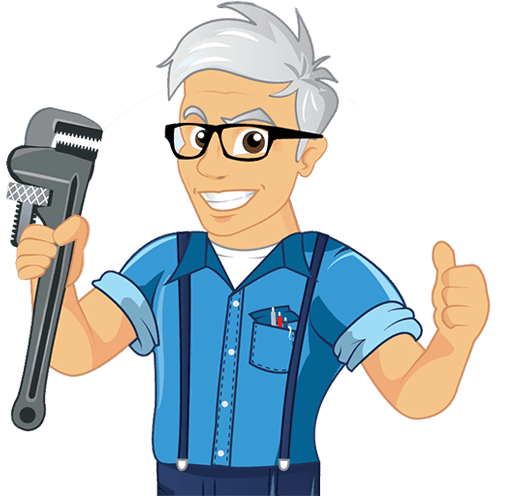Licensed Plumbers for Toilet Repair & Drain Service
If you are having toilet problems and can't get it working, call a plumber for help. There are a number of things that can make a blocked toilet ruin your day. We often deal with toilet plumbing issues and can get things cleared up very quickly.
Call now to set up an appointment with a
plumber in Vancouver.
Toilet Installation & Plumbing Service
When replacing an old malfunctioning toilet, the steps are pretty much the same as installing a new one from scratch. You start by prepping the floor after removing the old toilet.
Stuff a rag into the soil pipe to block sewer gas and prevent hardware from falling in. Check that the hole in the floor is large enough to accommodate the closet flange up to its collar. If the hole needs to be enlarged, trace around the flange's base with a pencil, then cut away the excess flooring with a jigsaw.
Don't cut any joists! Dry-fit the soil pipe into the closet bend. Place the flange over the soil pipe, then measure the gap between the bottom of the flange's collar and the finish floor. Remove the soil pipe and use a handsaw to trim it to the measurement in the previous step.
Remove burrs by scraping the cut edge with a utility knife. Dry-fit the flange to the soil pipe, and the soil pipe to the closet bend to ensure the flange's collar rests on the floor. This is the best way to install a toilet. As you can see the plumbing steps are straight forward.
We do a pretty good job working with toilets, and if you'd like a professional to handle this job, we'll be happy to do that for any work ranging from installing a plumbing fixture to a complete removal and toilet replacement with a new toilet. Your choice :-)
DIY Toilet - Inner Workings
A toilet has two main parts—the toilet tank and the bowl. The bowl holds water and connects to the drain for disposing of waste water and waste. The tank, which sits up behind the bowl, contains reserve water for refilling the bowl plus the devices for flushing clean water into the bowl and refilling the tank.
One of these toilet parts - the ballcock - is connected to the water supply and controls delivery of water to the tank. When the tank’s water rapidly drops down into the bowl (upon a flush), the pressure causes the bowl’s waste water to go down the drain. The drop in water level is sensed by a float, ball, or pressure gauge, and this triggers the ballcock to refill the tank.
Toilet Repair, Installation and Blocked Toilet Services
The Toilet Flapper Valve
When a conventional toilet is flushed, water from the tank rushes into the bowl through an orifice called the flush valve. Before you trip the lever, this valve is plugged with a rubber stopper, called a tank ball or flush valve seat ball.
Theses combined are called—not surprisingly—the flapper valve. Tripping the lever simply lifts the rubber stopper off the valve and…whoosh, the water flows into the toilet bowl.
A flush valve is 2 1/2 inches in diameter as is the ball-shaped part of the flapper. It hinges onto the vertical overflow pipe that’s next to the valve, and a small chain connects it to the trip lever. The advantage of a flapper over the earlier stoppers is that it doesn’t have as many parts to foul or get hung up so it’s less likely to let the tank “run” or leak into the bowl.
Install the Soil Pipe and Closet Flange
The next step to replace a toilet is to wipe PVC primer on the inside of the closet bend and on the outside of one end of the soil pipe. Apply PVC cement to those same surfaces and immediately twist the soil pipe into the closet bend.
Prime and apply cement to the free end of the soil pipe and the inside of the toilet flange. Twist and press the flange onto the soil pipe until the collar is seated on the floor.
Rotate the collar until its slots are positioned to the right and left of the hole. (The closet bolts, which will be inserted into the slots, must line up parallel to the wall behind the tank.) Secure the collar to the floor with stainless steel screws long enough to bite into the subfloor.
Click here to read the full article.
Toilets Drain to Sewer, Clogged Toilets Don't
When you flush a toilet, water in the tank is released into the bowl with a force that pushes everything down the drain. It doesn't matter what type of toilet you have this force is crucial in preventing a clog from forming. The waste flows through the drain to the sewage system or a septic tank. Once in the city sewers, the waste is treated and processed before being discharged.
The drain needs to remain clear and open so the waste can be disposed of properly. It is important to take care of your toilet's drain by not flushing anything that could clog it up. When a blockage happens, try using a plunger or a drain snake. If it's too much for you, call us and we'll have someone come out right away.
The Toto Toilet
TOTO, is the world's largest toilet manufacturer. It was founded in 1917, and is known for developing the Washlet and derivative products. The company is based in Kitakyushu, Japan, and owns production facilities in nine countries. The name "Toto" is an abbreviation of the two Japanese words forming its full name, Tōyō Tōki (Oriental Ceramics).
When it comes to anything related to toilet repair or a new toilet installation, we will be happy to assist. Call any time for an appointment.






